Mastering LinkedIn: The Three-Part System That Grows Your Business and Your Network
Oct 01, 2025
Why Founders, CEOs, and Teams Can’t Afford to Ignore These Basics Anymore
If you’re building a business in 2024, you can’t afford to treat LinkedIn as just another “digital resume.” The platform has changed, your customers’ expectations have changed, and if you’re still thinking of LinkedIn as a place to tackle in your spare time, or worse, put off entirely, you’re leaving serious revenue and relationship opportunities on the table.
On this week’s episode of The Scalable Marketing Machine Podcast, I sat down with Gabby de Avila of Gabby Agency, whose LinkedIn strategies have not only helped founders and experts stand out but have also driven measurable results and real business connections. Let’s break down the system she shared and how you can use it to elevate your own LinkedIn presence starting today.
Your Profile: First Impressions Matter More Than You Think
Imagine this: a prospect clicks on your name. You have exactly 30 seconds, if that, to signal credibility, clarity, and authority. Your LinkedIn profile isn’t just a collection of stats; it’s your landing page. The reality is, people aren’t leaving LinkedIn to hunt down your story; if your profile doesn’t represent you and your business well, you’re out before you even get in.
Take a look at your profile right now. Are you proud of that photo? Does your headline explain what you actually do? Is your About section making it easy for prospects to trust you? Don’t overlook the power of optimizing these elements. And if you don’t already have a Company Page, that’s a quick win; five minutes to set up, even if you’re just getting started.
I’ll be direct here: the days of choosing between “business” and “personal” on LinkedIn are over. People want both. Your Company Page should look legit: banner, logo, tagline, and some evidence you’re active. But your personal profile is where real storytelling happens. The best approach? Use both, cross-promote, and let each highlight its unique strengths. Tell your professional story, share about your business, and make it easy for someone to say, “Yes, I want to know more.”
Content That Converts: Stop Posting for the Sake of Posting
Let’s talk about content because posting for the sake of “being active” is over. You need content that teaches, differentiates, and makes people see you as the authority you are. I love Gabby’s 4-1-1 system here: four educational posts, one insight (usually about your company), and one promotional post for every six you put out. This keeps you from sounding too salesy or, just as bad, too generic.
Here’s where you shine: create posts that teach, share opinions on industry trends, provide numbers or statistics from your field, and offer up quick tips. If you’re sharing visuals or infographics, even better, those posts consistently perform well with the current LinkedIn algorithm.
What you don’t want? A feed full of sales pitches or scattered, “whatever’s on my mind” postings. Your job is to help your audience, not just hard sell to them. Remember, you want your company and your profile to be known as experts and leaders in your niche. That only happens if your content is relevant, clear, and genuinely useful.
Engagement: The Overlooked Growth Engine on LinkedIn
Most people get this wrong, and it’s why their LinkedIn presence stalls out. If you really want traction, lead generation, and a LinkedIn profile that works for your business, engagement cannot be optional. In fact, commenting and engaging daily, even if you aren’t posting every day, will get you better results than nearly anything else.
Here’s what people forget: LinkedIn’s algorithm gives love to those who interact. If you’re showing up in comment sections, sharing authentic responses (not AI-generated fluff), and refreshing who you engage with every month, the right people will see your posts. Ditch the “engagement pod” hacks; LinkedIn is actively penalizing that these days. You want to build wide, genuine circles, not artificial comment rings.
A quick tip: create an engagement list of target prospects, thought leaders, and creators in your industry. Dedicate 30 minutes each business day to interact thoughtfully with their content. This compounds your visibility, leads, and relationships; plus, it’s truly social networking, not just broadcasting.
Make It a Habit: Build Your Own Routine (and Set Expectations for Your Team)
If you’re delegating LinkedIn, make sure your social media manager knows that engagement is just as important as posting. Set KPIs that include comments and active conversation, not just post scheduling and “impressions.” I’ve found that 30 minutes a day engaging with targeted profiles, plus another block of time for content creation and (if you’re running outreach or sales) a further hour on relationship-building messages, creates the foundation for long-term results.
Be patient. Measuring success here is about months, not days, but in three months of consistent, strategic activity, you’re going to see real changes in network, leads, and inbound opportunities.
Show Up, Stay Consistent, and Build Trust
LinkedIn isn’t about churning out more posts. It’s about clarity, consistency, connection, and intention. Optimize your profile with your next customer in mind. Share content that teaches and inspires. And make engagement an unmissable daily practice.
The truth is, no platform does professional connection better than LinkedIn right now, and when you show up the right way, with the right system, the results follow. So go out there, focus on clarity, and watch the doors open.
For more step-by-step tactics and examples, listen to the full episode with Gabby on The Scalable Marketing Machine Podcast. Let’s build your presence and your business, the way it’s meant to be built.
Take a listen! 👇
Get more like this.
New ideas, motivation and inspiration delivered to your inbox.
We hate SPAM. We will never sell your information, for any reason.

